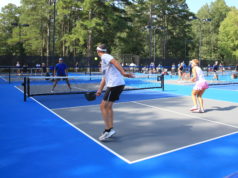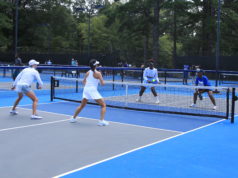WHAT’S THE WORD ON BREAKS?
Is a break allowed between the first and second sets?
Sandy Depa, Senior Leagues Vice President
In a match, play should be continuous, from the first service ball struck to the end of the match. At the end of each set, there shall be a maximum set break of 120 seconds (2 minutes), according to USTA Rule 29a. The maximum time starts from the moment that one point finishes until the first service is struck for the next point.
In an ALTA match, there also is the maximum break of 120 seconds allowed between the first and second sets. However, there is a maximum rest period/break of 10 minutes allowed in an ALTA match between the second and third sets.
_______
IN A PICKLE OVER LINES
Does ALTA approve for play courts that have pickleball lines? My community is thinking about putting some pickleball lines on one of our courts when we resurface. Have you run into issues and/or complaints about playing on courts with those lines?
Kim Davies, Thursday Women Vice President
As best as I can tell, there are no rules for having court surfaces serving multiple purposes. We usually leave it up to the HOA or facility to decide how they want to use their courts. I will caution you on confusion of which lines are being used for an official ALTA match. ALTA tennis players should have the reasonable expectation to make correct line calls. There is also the issue of the court surface being damaged and discolored because of the additional use of them. If there are complaints, we will conduct an inspection. If the complaints are warranted, we could ask for the problem to be remedied or place a block on the facility for future ALTA tennis matches.
_______
PROBLEM WITH LIGHTING
At a make-up match, our home courts had a light that was not working. The opponents were upset about it, stating that, “All lights must be in working condition, as per ALTA rules.” The away team offered to play at their courts, but when we arrived they could not turn their lights on. They claimed we defaulted the match because we were unable to provide our home court but then offered to play the match at a nearby park and we agreed. Should my partner and I have defaulted the match because of the missing light, and were our opponents right for demanding a default when they said their courts had adequate lighting?
Joyce Vance, Sunday Women Vice President
There are two aspects of this question. The first is whether a light being out makes the courts unplayable. There is no specific rule concerning the number of lights required on a tennis court or the number of missing lights that cause courts to be unplayable. The condition of the court is a judgement call for the players on the court.
If, in the judgement of the players, the loss of lights makes the court unsafe for play, ALTA rule IV.J takes effect and the visiting team has the first option to provide its home courts. So, you were correct to go to your opponent’s courts. Since they were unable to provide their home courts, the home team had the option to provide alternate courts within the approved ALTA area, not the visiting team. If the home team is unable to find an alternate court, you must contact your coordinator. However, in this case it is good to know that all players worked to get the match played.
_______
LET’S ‘BEE’ SURE
During an ALTA doubles match, a bee flew into my T-shirt in the middle of a rally. I yelled “let” and stopped the point so I could take off my T-shirt and get rid of the bee before getting stung. I expected we would play the point over, but our opponents refused to accept the “let” call and instead took the point. What is the correct ruling?
Warren Fraser, Men’s League Vice President
The Code Section 36 addresses a “Let due to unintentional hindrance:” A player who is hindered by an opponent’s unintentional act or by something else outside the player’s control is entitled to a let only if the player could have made the shot had the player not been hindered. The bee in the shirt is enough of a distraction to create a let. However, the opponent should have denied the let if the player could not have reached the ball before it went out of play.




